In today’s competitive market, a strong brand isn’t just a name—it’s a measurable asset that drives consumer trust, loyalty, and long-term business growth. But how can companies effectively measure the true value of their brand? That’s where the Brand Asset Valuator Model(BAV) comes in. Developed by global marketing agency Young & Rubicam (now part of VMLY&R), the BAV Model is one of the most comprehensive frameworks for assessing a brand’s strength and overall equity.
This model evaluates brands based on consumer perceptions across four key dimensions—Differentiation, Relevance, Esteem, and Knowledge—to provide deep insights into how a brand is positioned in the marketplace. Whether you’re building a new brand or re-evaluating an established one, understanding the BAV Model can help you make strategic decisions that resonate with your audience and drive value over time.
In this blog, we’ll explore the history of the BAV Model, its core components, practical benefits, and how you can apply it to enhance your brand strategy.
History and Development of the BAV Model
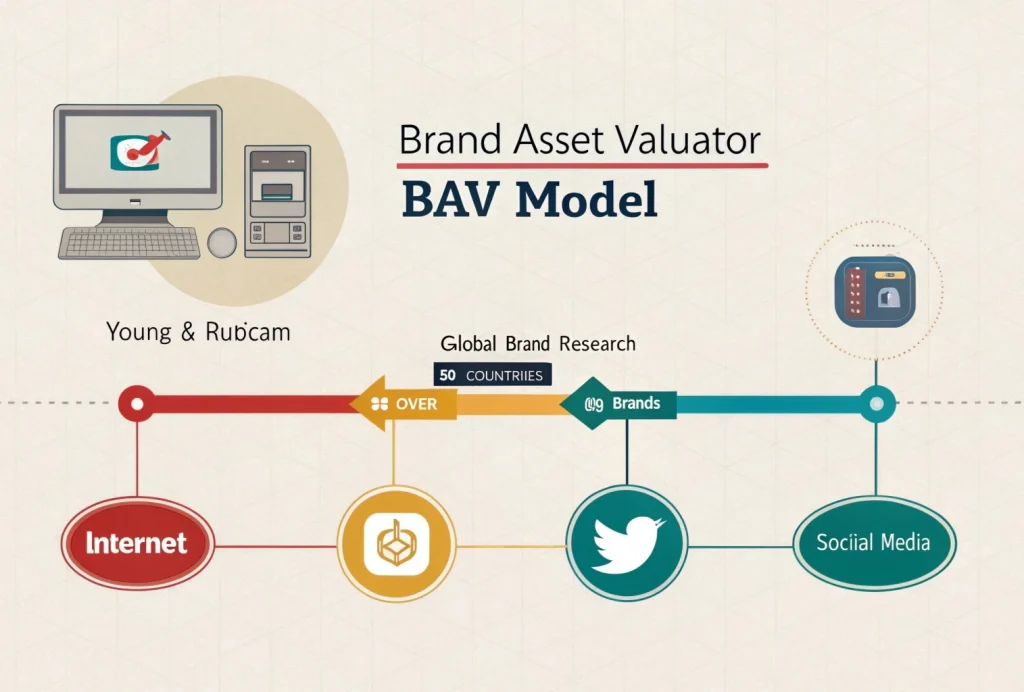
The Brand Asset Valuator (BAV) Model was created in the early 1990s by a global marketing company called Young & Rubicam (Y&R). At that time, companies were starting to realize that a brand is more than just a logo or name—it’s something that influences how people feel and make buying decisions.
To better understand what makes a brand strong, Y&R started one of the biggest brand research projects in the world. They collected information from thousands of consumers in over 50 countries, studying how people see and respond to different brands. Over the years, they analyzed more than 50,000 brands.
What made the BAV Model different was its focus on how consumers see the brand—not just the company’s sales or profits. It looked at things like how unique the brand feels, how trustworthy it is, and how much people know about it. This approach helped businesses understand what’s really going on in the minds of their customers.
As time went on and marketing changed—especially with the rise of the internet and social media—the BAV Model continued to grow and adapt. Today, it’s still used by many companies around the world to measure brand value and plan better brand strategies.
Key Components of the Brand Asset Valuator Model
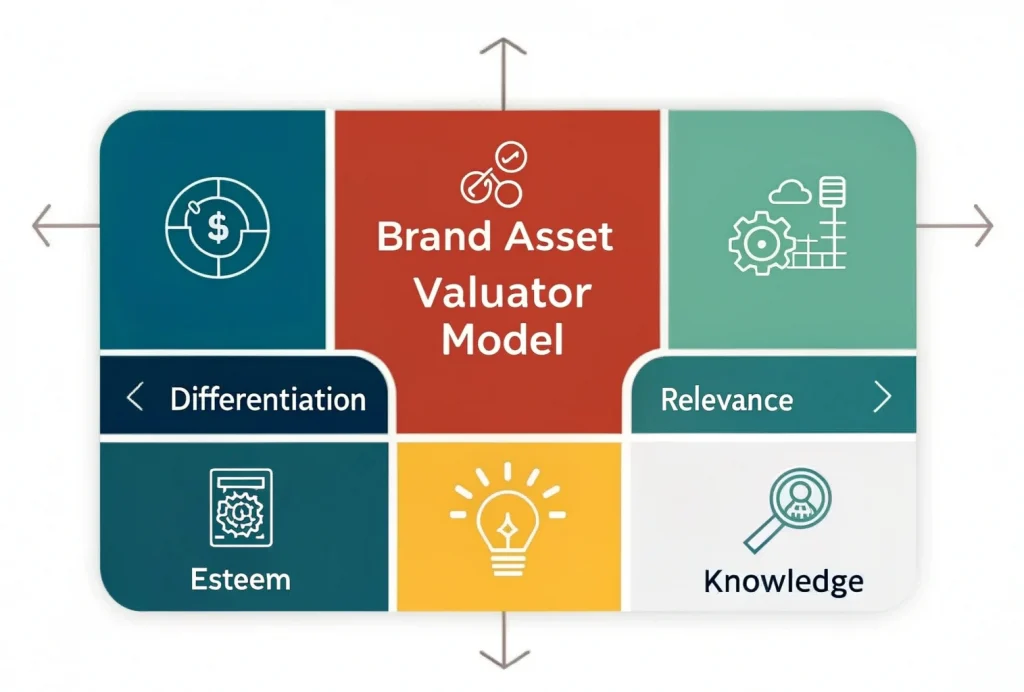
The BAV Model is built around four main components that help measure how strong and valuable a brand is. These four parts are:
- Differentiation
- Relevance
- Esteem
- Knowledge
Together, these elements show how people feel about a brand and how well it is doing in the market. Let’s look at what each one means:
1. Differentiation
This shows how unique or different a brand is from others. A brand that stands out from the crowd often gets more attention and builds strong emotional connections with people.
2. Relevance
This tells us how important or useful a brand is to people in their daily lives. Even if a brand is different, it must also be relevant—meaning people need to feel that it meets their needs or fits into their lifestyle.
3. Esteem
Esteem is about how highly people respect or value a brand. A brand with high esteem is usually trusted, admired, and seen as high quality.
4. Knowledge
This measures how well people know and understand a brand. It’s not just about name recognition—it’s about whether people really understand what the brand stands for and what it offers.
These four parts work together in the BAV Model to help brands figure out what they’re doing well and where they need to improve. For example, if a brand has high knowledge but low esteem, people might know the brand but not think highly of it. This kind of insight is very helpful for planning marketing and branding strategies.
Explore our online programs to become future-ready
Transform your career with industry-aligned courses designed by experts.
How the BAV Model Measures Brand Strength and Brand Stature
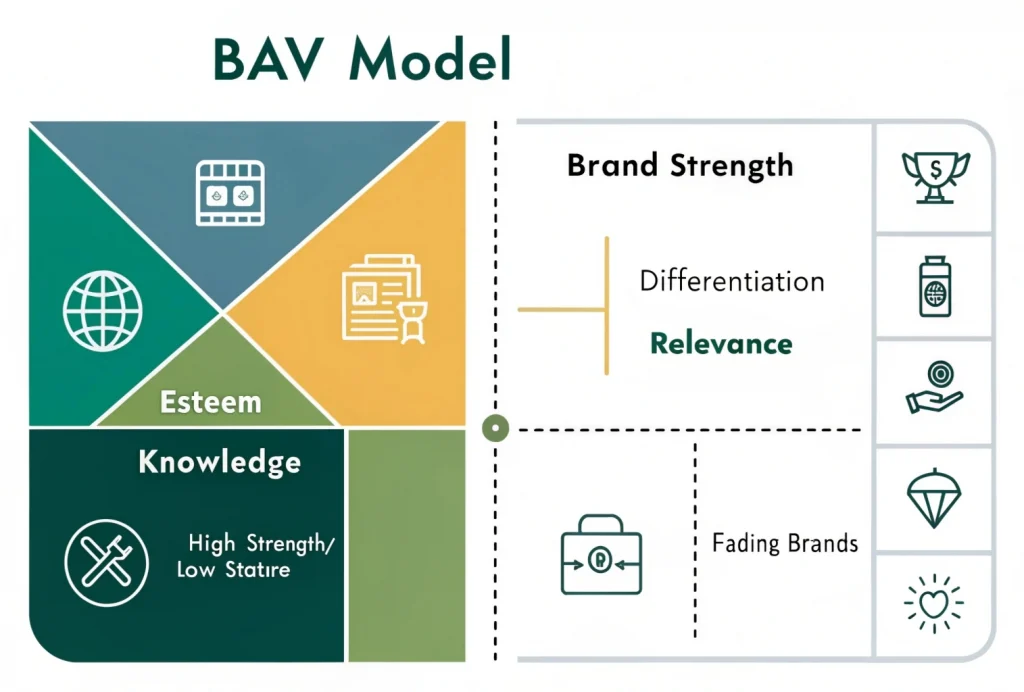
The BAV Model doesn’t just look at individual brand qualities—it also groups them into two bigger ideas: Brand Strength and Brand Stature. These help companies understand where their brand stands in the market and how it’s likely to perform in the future.
1. Brand Strength
Brand Strength shows how strong and healthy a brand is right now. It focuses on two key parts of the BAV Model:
- Differentiation (how unique the brand is)
- Relevance (how meaningful the brand is to people)
When a brand scores high in these two areas, it means it’s doing a great job standing out and connecting with customers. A strong brand like this is more likely to grow and succeed in a competitive market.
2. Brand Stature
Brand Stature shows how well-known and respected the brand is. It’s based on:
- Esteem (how much people respect and trust the brand)
- Knowledge (how well people know and understand the brand)
High brand stature means the brand is not only familiar to people, but also admired. This usually happens when a brand has been around for a while and built a solid reputation.
Combining Both to Plan Brands next Steps
By looking at both Brand Strength and Brand Stature, companies can figure out their brand’s position in the market. For example:
- A brand with high strength but low stature might be a new and exciting brand that people are just starting to notice.
- A brand with high stature but low strength might be an older brand that people know but no longer find exciting or relevant.
Understanding this balance helps brands plan their next steps—whether that means improving their reputation, becoming more unique, or reaching new audiences.
Benefits of Using the Brand Asset Valuator Model
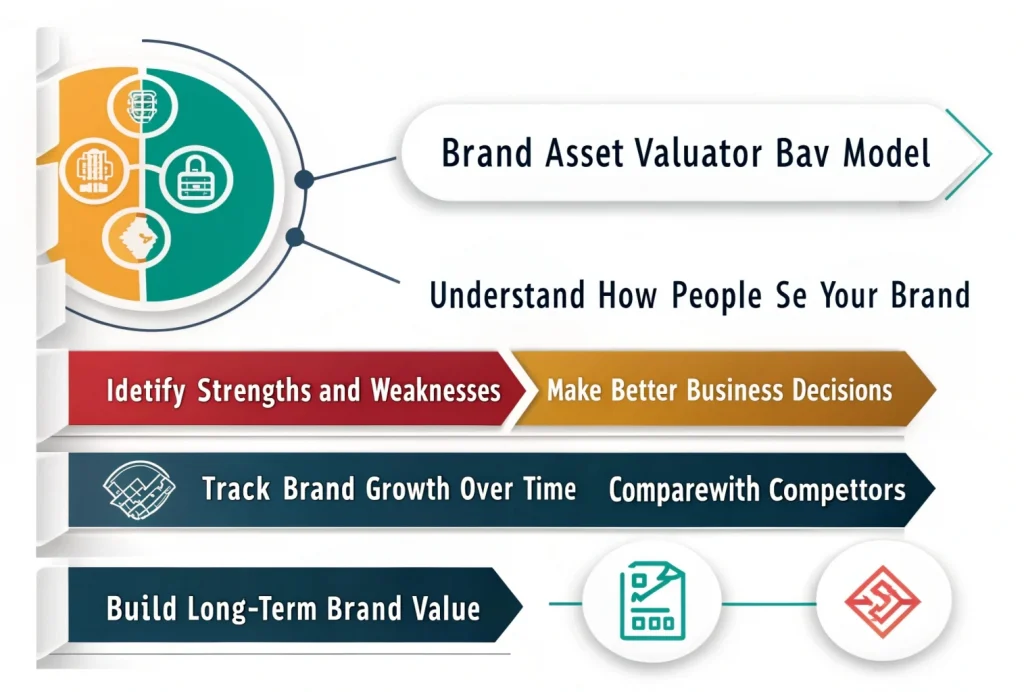
The Brand Asset Valuator (BAV) Model is a helpful tool for businesses of all sizes. It gives companies a deeper understanding of how people see their brand and what they can do to improve it. Here are some simple and important benefits of using the BAV Model:
| Benefit | Explanation |
|---|---|
| Understand How People See Your Brand | Learn how consumers truly feel about your brand—whether they find it different, trustworthy, or relevant. Helps shape better brand strategies. |
| Identify Strengths and Weaknesses | Measures your brand using four key factors—Differentiation, Relevance, Esteem, and Knowledge—to highlight what’s working and what needs improvement. |
| Make Better Business Decisions | Helps you make smarter decisions in marketing, product development, and pricing by aligning strategies with consumer perception. |
| Track Brand Growth Over Time | Allows regular monitoring of brand performance to see if it’s improving, staying strong, or falling behind in the market. |
| Compare with Competitors | Enables you to compare your brand against others in your industry using global BAV data, helping identify your unique market position. |
| Build Long-Term Brand Value | Helps develop a strong brand that people trust and stay loyal to over time by balancing current strength and long-term reputation. |
Understand How People See Your Brand
Learn how consumers truly feel about your brand—whether they find it different, trustworthy, or relevant. Helps shape better brand strategies.
Identify Strengths and Weaknesses
Measures your brand using four key factors—Differentiation, Relevance, Esteem, and Knowledge—to highlight what’s working and what needs improvement.
Make Better Business Decisions
Helps you make smarter decisions in marketing, product development, and pricing by aligning strategies with consumer perception.
Track Brand Growth Over Time
Allows regular monitoring of brand performance to see if it’s improving, staying strong, or falling behind in the market.
Compare with Competitors
Enables you to compare your brand against others in your industry using global BAV data, helping identify your unique market position.
Build Long-Term Brand Value
Helps develop a strong brand that people trust and stay loyal to over time by balancing current strength and long-term reputation.
Steps to Apply the BAV Model for Your Brand
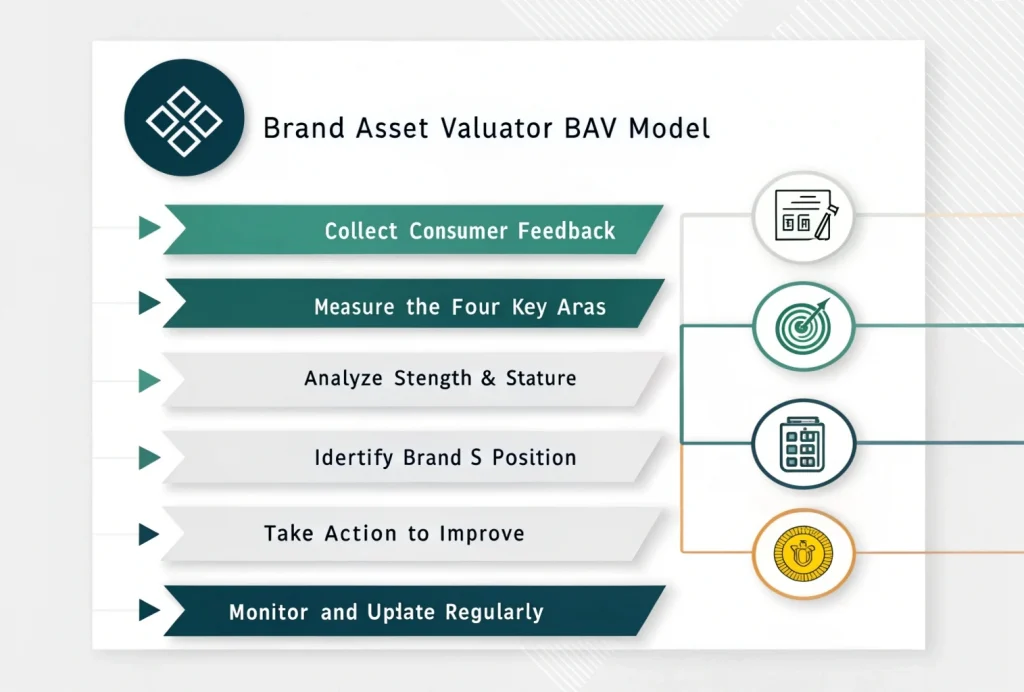
If you want to improve your brand using the BAV Model, there are a few simple steps you can follow. These steps help you understand how your brand is doing and what actions you can take to grow it.
| Step | What to Do | Why It Matters |
|---|---|---|
| Collect Consumer Feedback | Use surveys, interviews, or online reviews to gather opinions on Differentiation, Relevance, Esteem, and Knowledge. | Helps you understand what people really think about your brand. |
| Measure the Four Key Areas | Score your brand on: • Differentiation (How unique?) • Relevance (How meaningful?) • Esteem (How respected?) • Knowledge (How well-known?) | Breaks down brand performance into clear, measurable parts. |
| Analyze Strength & Stature | Group the scores into: • Brand Strength = Differentiation + Relevance • Brand Stature = Esteem + Knowledge | Shows how healthy and well-known your brand is overall. |
| Identify Brand’s Position | Use the scores to find out your brand’s type: • New & exciting • Fading brand • Leading brand | Helps you know where you stand and what direction to take next. |
| Take Action to Improve | Work on weaker areas: • Low Differentiation → Highlight uniqueness • Low Esteem → Build trust • Low Relevance → Connect with audience needs | Strengthens your brand where it’s needed most. |
| Monitor and Update Regularly | Re-check your scores every few months or yearly. Update your strategy based on new results. | Keeps your brand growing and in touch with changing consumer views. |
Collect Consumer Feedback
What to Do: Use surveys, interviews, or online reviews to gather opinions on Differentiation, Relevance, Esteem, and Knowledge.
Why It Matters: Helps you understand what people really think about your brand.
Measure the Four Key Areas
What to Do: Score your brand on Differentiation, Relevance, Esteem, and Knowledge.
Why It Matters: Breaks down brand performance into clear, measurable parts.
Analyze Strength & Stature
What to Do: Combine Differentiation + Relevance for Strength; Esteem + Knowledge for Stature.
Why It Matters: Shows how healthy and well-known your brand is overall.
Identify Brand’s Position
What to Do: Use scores to categorize: New & Exciting, Fading Brand, or Leading Brand.
Why It Matters: Helps you know where you stand and what direction to take next.
Take Action to Improve
What to Do: Improve weak areas like uniqueness, trust, or audience relevance.
Why It Matters: Strengthens your brand where it’s needed most.
Monitor and Update Regularly
What to Do: Recheck scores periodically and refine strategy accordingly.
Why It Matters: Keeps your brand growing and aligned with consumer expectations.
Examples of Brands Analyzed Using the BAV Model
To better understand how the BAV Model works in real life, let’s look at a few well-known brands that have been studied using this model. These examples show how different brands score across the four key areas—Differentiation, Relevance, Esteem, and Knowledge—and what that means for their success.
1. Apple
- Differentiation: Very high – Apple stands out because of its sleek design, innovation, and unique brand experience.
- Relevance: High – Apple products are widely used and fit well into people’s everyday lives.
- Esteem: High – Many people admire Apple for its quality and leadership in technology.
- Knowledge: High – Almost everyone knows what Apple offers and what it stands for.
Apple is a perfect example of a brand with both strong Brand Strength and high Brand Stature. It is well-loved, trusted, and instantly recognized around the world.
2. Tesla
- Differentiation: Very high – Tesla is known for its cutting-edge electric cars and bold approach to technology.
- Relevance: Medium – While popular, Tesla may not yet be relevant to everyone due to its pricing and niche market.
- Esteem: High – People respect Tesla for innovation and sustainability.
- Knowledge: High – Most people are aware of Tesla, even if they haven’t owned one.
Tesla has high Brand Strength due to its uniqueness but is still building broader relevance and long-term stature.
3. Nokia (Today)
- Differentiation: Low – Not seen as unique in today’s smartphone market.
- Relevance: Low – No longer plays a major role in most people’s lives.
- Esteem: Medium – Older generations may still respect the brand.
- Knowledge: High – Many people still remember Nokia from its earlier success.
Nokia has high Brand Knowledge but low Brand Strength, showing how a brand can lose relevance over time if it doesn’t keep evolving.
These real-life examples show how the BAV Model helps brands understand their current position and make better decisions for the future.
Comparison: BAV Model vs Other Brand Valuation Models
There are many ways to measure a brand’s value. While the BAV Model focuses on consumer perception, other models use different methods. Let’s compare the BAV Model with some other popular brand valuation models to see how they differ.
| Model | What It Focuses On | How It’s Different from BAV |
|---|---|---|
| BAV Model | Looks at how people feel about a brand: Differentiation, Relevance, Esteem, Knowledge | Focuses on consumer opinions and emotional connections, not just money or numbers |
| Interbrand Model | Measures brand value based on financial performance, brand strength, and future earnings | More focused on financial data and future business potential |
| BrandZ Model (by Kantar) | Combines consumer insights with financial performance | Mixes emotional factors (like BAV) with financial results; a balanced approach |
| Brand Finance Model | Calculates the monetary value of a brand using income-based methods | Mostly about how much a brand is worth in money—less focus on consumer feelings |
BAV Model
Focus: Looks at how people feel about a brand: Differentiation, Relevance, Esteem, Knowledge
How it’s different: Focuses on consumer opinions and emotional connections, not just money or numbers.
Interbrand Model
Focus: Measures brand value based on financial performance, brand strength, and future earnings
How it’s different: More focused on financial data and future business potential.
BrandZ Model (by Kantar)
Focus: Combines consumer insights with financial performance
How it’s different: Mixes emotional factors (like BAV) with financial results; a balanced approach.
Brand Finance Model
Focus: Calculates the monetary value of a brand using income-based methods
How it’s different: Mostly about how much a brand is worth in money—less focus on consumer feelings.
Key Takeaway:
- The BAV Model is best for understanding what people think and feel about your brand.
- Other models, like Interbrand or Brand Finance, are better for calculating brand value in financial terms.
If you’re looking to improve brand image or connect better with your audience, the BAV Model is a great choice. If you’re trying to sell your company or attract investors, financial models may be more useful.
Limitations of the Brand Asset Valuator Model
While the BAV Model is a helpful tool for understanding brand value from the consumer’s point of view, it’s not perfect. Like any model, it has a few limitations that are important to keep in mind.
| Limitation | Explanation |
|---|---|
| Focuses Mostly on Perception | It mainly looks at consumer opinions, not actual business performance. A popular brand might still struggle financially. |
| Needs a Lot of Consumer Data | To use it well, you need detailed feedback from your audience, which can be time-consuming and costly to gather. |
| Doesn’t Measure Short-Term Changes | The model is better for long-term brand value and may not show quick changes or short-term marketing success. |
| Doesn’t Include Financial Metrics | It doesn’t factor in sales, profit, or market share—so it must be combined with financial models for a full view. |
| May Not Suit All Industries | It works best for consumer brands, but may not be as useful for business-to-business (B2B) companies. |
Focuses Mostly on Perception
It mainly looks at consumer opinions, not actual business performance. A popular brand might still struggle financially.
Needs a Lot of Consumer Data
To use it well, you need detailed feedback from your audience, which can be time-consuming and costly to gather.
Doesn’t Measure Short-Term Changes
The model is better for long-term brand value and may not show quick changes or short-term marketing success.
Doesn’t Include Financial Metrics
It doesn’t factor in sales, profit, or market share—so it must be combined with financial models for a full view.
May Not Suit All Industries
It works best for consumer brands, but may not be as useful for business-to-business (B2B) companies.
Conclusion
Building a strong brand isn’t just about selling more—it’s about making people trust, remember, and connect with your brand. The Brand Asset Valuator (BAV) Model is a great tool to help with that. It looks at four simple things:
- How different your brand is
- How important it is to people
- How much people respect it
- How well people know it
By using the BAV Model, you can understand what people really think about your brand and find out what’s working—and what’s not. It’s helpful for planning your marketing, fixing weak spots, and making your brand stronger over time.
Even though the BAV Model doesn’t include financial data, it’s still a smart way to see your brand from your customers’ point of view. When you know how people feel about your brand, you can make better choices and grow your business the right way.


Leave a Reply